 |
|
Israel Journal COLLEEN TINKER |
||||
NUMBER 10 — THURSDAY, NOVEMBER 6, 2008
Masada, Ein Gedi, Jerusalem, and Bethlehem
What a day! I am writing this early on the morning of Friday, November 7, instead of at the end of Thursday because the day was SO full and tiring there was no hope I could stay awake to finish this!
Masada
Thursday, November 6, began with a short bus ride from our hotel at the Dead Sea to Masada. Masada was an ancient fortress built originally by Herod the Great (yes, his projects have left a defining signature over this area) as his winter palace. Masada is a distinct mountain which was leveled on top in order to build, and Herod’s palace itself was clearly visible on the north east edge of the mountain. He had three terraces leveled like giant stair steps down the north-eastern side of the mountain, and on those terraces he had built out various portions of his palace. The view from these terraces is breathtaking; the Dead Sea extends north and south as far as one can see, and between Masada and the Sea is the totally barren, rolling terrain of the Judean desert. Herod built his palace in exactly that spot because a dry, cool breeze blows nearly continuously across that face of the mountain.
Geographically, Masada is interesting. I had heard of it, but I’d never understood exactly where it was or how it “fit” with everything else I had heard about Judea. It is, as I mentioned, a significant feature of the Judean desert and it overlooks the Dead Sea. In order to reach the top, one either must take the aerial tram or climb up the “snake trail” which traverses back and forth across the south-eastern face of the mountain. The elevation gain is about 1,000 or 1,100 feet, and it rises from the level of the Dead Sea, and at the top it is roughly sea level. That detail gives you some idea how low the area of the Dead Sea is, and you can also imagine how much atmospheric pressure there is at the Dead Sea. (It has the highest concentration of oxygen on the air on the planet at the Dead Sea, and bottles compress and put contents under pressure as one descends to it.)
The story behind Masada is tragic. Herod the Great died in 4 BC, so its use as an official palace ended. Because of its location and structure, however, it was an ideal fortress—nearly unassailable. In 66 AD the Jews revolted against the Romans. Ultimately it was a hopeless battle, and in 70 AD Titus sacked the temple, Jerusalem fell, and the Jews were scattered. It was all over—except for Masada. A number of Jews who refused to give up and who had a strong zealot-mindset had taken refuge there with their families. They were not going to surrender, and they resisted the Romans. The Romans, meanwhile, did not consider their conquest finished until they captured the Jews garrisoned at Masada.
To make a long story short, in 73 AD the Romans and the Jews as Masada had a final show-down. The Romans had eight camps of soldiers on the plain below Masada, and they built a siege ramp up which they brought a battering ram to tear down the fortress. The Jews built a wooden double wall between which they put sand bags, so when the Romans battered, they couldn’t really destroy the wall. The Romans responded by shooting burning arrows into the wall to burn it, but as they did so, the wind changed and blew all the smoke directly into the Roman army.
Ultimately, the Romans inflicted enough damage that they knew that with one more assault they could take Masada. Meanwhile, the Jews held a meeting. They decided that they would rather die than be taken as slaves, and they selected ten men to oversee their group suicide pact. Using a technicality in Jewish law to justify their decision, they agreed that the men would kill their own wives and children. The ten would then, according to an order selected by drawing lots, kill one another, and the final man would fall on his own sword. Interestingly, pottery shards with men’s names on them have been found at Masada, and archeologists believe these are the lots used to determine the final order of death.
When the Romans returned the next day to finish their job, they found only one woman and two children alive—and a pile of armor where the men had thrown their shields before they died. Masada has become a symbol of Jewish pride and bravery.
Ein Gedi
From Masada we drove to Ein Geadi, which means “spring of the goats”. Ein Geadi is an oasis that rises out of the dry Judean desert, still within view of the Dead Sea, and it is the site of many of David’s activities early in his life. The caves in the hills around the stream which flows through the desert from the water which begins high in the mountains and forms at least three lovely waterfalls as it descends were the places where David hid from Saul when Saul was trying to kill him. He wrote Psalm 57 when he fled from Saul and hid in Ein Geadi.
Psalm 57 begins, “Have mercy on me, O God, have mercy on me, for in you my soul takes refuge. I will take refuge in the shadow of your wings until the disaster has passed.”
Another story I’ve always found fascinating happened at Ein Geadi—and now I have a context for it. 2 Chronicles tells the story of when Jehoshephat was king. He heard that a group of Edomites (descendents of Esau from the region of Jordan) and Moabites (also from the plains across the Dead Sea—the area where Israel was camped when Moses went up Mt. Nebo to die) had come to Ein Geadi to stage a surprise attack on Israel. This geographical approach was not a normal way to attack, and Jehoshephat’s defenses were down.
He prayed and rallied the troops—and he put the choir in front of the army and sent then to meet the enemy. When the soldiers and the choir reached the camp of the Midianites and Edomites, and they discovered that God had caused confusion to come among them, and they had already begun to turn on and to kill each other.
After hiking to the top waterfall at Ein Geadi, dipping hands or feet into the very stream where we know David was 3,000 years ago, marveling at the view of the very blue Dead Sea in the distance, the lush green of the foliage along the stream as it wound down the otherwise bone-dry hills, we again boarded our bus and began our ascent to Jerusalem.
Jerusalem and Bethlehem
As we began to leave the Judean desert behind, Gary told us that the Israelites had a set of Psalms called the “Songs of Ascent” which they would sing as they went up to Jerusalem each year for the feasts. Their ascent was both geographical and spiritual, and the psalms reflected their deep commitment to God and to their own identity with Him.
Here is the second song of ascent: Psalm 121:
I lift up my eyes to the hills—where does my help come from? My help comes from the Lord, the Maker of heaven and earth. He will not let your foot slip—he who watches over you will not slumber; Indeed, he who watches over Israel will neither slumber not sleep. The Lord watches over you—the Lord is your shade at your right hand; the sun will not harm you by day nor the moon by night. The Lord will keep you from all harm—he will watch over your life; the Lord will watch over your coming and going both now and forevermore.”
Jerusalem is truly a city on a hill—several hills, in fact. It is no longer desert but the rocky hills are dotted with olive trees and pine trees. It is beautiful—much more beautiful than I had ever imagine it.
Our last stop was at Bethlehem which today seems to be part of Jerusalem—but it is separated from Jerusalem by the wall that separates Palestine from Israel. At the wall we had to leave behind our Jewish guides who were not allowed inside the Palestinian borders. Once inside, we received a Palestinian Christian guide who showed us the Church of the Nativity in Bethlehem. The church was originally built in the fifth century, and it has actually preserved what is probably the actual site of Jesus’ birth—one of the few spots in the Holy Land that we are quite sure is accurate.
Today, however, the church is shared by three groups: Catholic, Orthodox, and Armenian. Each has a chapel, and pilgrims from all over the world come to pay homage. The church was crowded with visitors, and the actual places of Jesus’ birth and of the manger have been made into holy shrines. The place of Jesus’ birth has been marked by a silver star in the floor which covers the spot, and the manger site is also enshrined. Candles and religious symbols are everywhere, and the visiting pilgrims come and prostrate themselves on the floor to kiss the silver star where Jesus was born.
After we saw the shrines, we gathered in the beautiful nave of the Catholic chapel—and Gary recited John 1:1-18: “In the beginning was the word, and the Word was with God, and the Word was God…”It put everything into perspective, and the incredible fact that God became man and brought grace and truth to fulfill the law Moses had brought (see John 1:17) so we can become children of God (John 1:12) moved me. Michael Hicks led us in singing, “Hark, the Herald Angels Sing”, and then he sang “Oh, Lord Most Holy” a cappella, and the notes echoed and mingled in that beautiful Romanesque chapel with its vaulted ceiling.
As we left the chapel, the amplified sounds of the Muslim prayers were filling the sunset evening. It jarred me with the reality of what Bethlehem now is: a Palestinian city from which the Christians are leaving. Today Bethlehem is 75% Muslim and only 25% Christian—and the Christians are, apparently, mostly Catholic and Orthodox. The city where Jesus was born has nearly lost the spark of Christianity, and its people are in darkness. I was overwhelmed by the sadness of it, and I prayed as we left Bethlehem for its citizens to come to the knowledge of the One in whose birthplace they live.
Today we will begin seeing Jerusalem. We appreciate your continued prayers; Richard’s back is much improved, and we praise God for this opportunity.
Copyright 1999-2008 Graphics Studio, Redlands, CA USA. All rights reserved. Revised November 17, 2008. Use of this site and forum signifies your acceptance of the Terms and Conditions. Send comments and questions to formeradventist@gmail.com
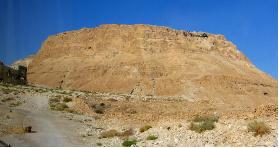
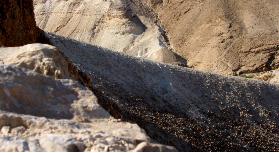 The Romans built a ramp that made it possible for them to finally conquer Masada, and when they did they found that the Jews had committed mass suicide.
The Romans built a ramp that made it possible for them to finally conquer Masada, and when they did they found that the Jews had committed mass suicide.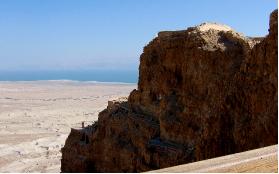 Herod's palace occupied the stair-stepped edge of Masada.
Herod's palace occupied the stair-stepped edge of Masada.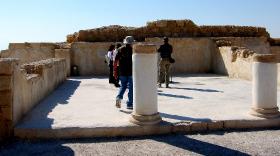 We got to visit Herod's bedroom.
We got to visit Herod's bedroom.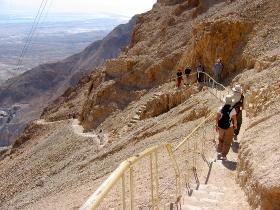 Some of the group walked down the snake path instead of riding the tram back to the busses. The path has over 800 steps.
Some of the group walked down the snake path instead of riding the tram back to the busses. The path has over 800 steps.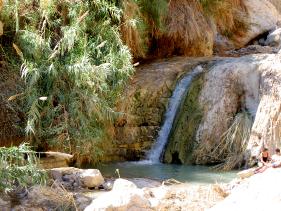 The Ein Geadi spring is the place where David hid from king Saul.
The Ein Geadi spring is the place where David hid from king Saul.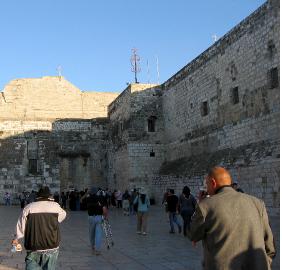 Manger Square in Bethlehem leads to the Church of the Nativity, the likely spot of Jesus' birth.
Manger Square in Bethlehem leads to the Church of the Nativity, the likely spot of Jesus' birth.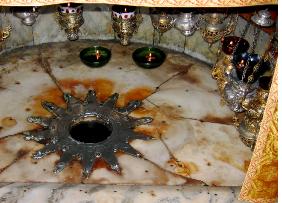 A grotesque star marks the spot believed to be the exact location of Jesus' birth.
A grotesque star marks the spot believed to be the exact location of Jesus' birth. 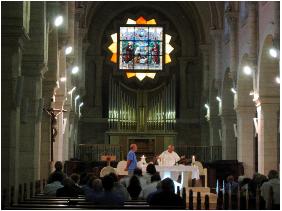 Michael Hicks led us in singing "Hark, the Herald Angels Sing" in the Catholic chapel.
Michael Hicks led us in singing "Hark, the Herald Angels Sing" in the Catholic chapel.